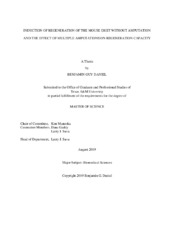| dc.description.abstract | The phenomenon of mammalian digit tip regeneration offers a promising avenue for research in regenerative medicine, as well as the processes of tissue regeneration more generally. Recent developments in gene expression analysis and immunohistochemical studies of the regenerating mouse tissues offer novel insights into the mechanisms by which cells self-organize into complex systems during the growth and development of the organism. While it is generally known within the field of regenerative medicine that the digits of mice are capable of regenerating after amputation, it is less well known that mouse digits may undergo a similar episode of regeneration following injuries which do not directly damage the bone of the distal phalanx. In this work, I will: 1) extensively characterize how the regenerative process can be initiated without amputation, 2) show how changes in the relative bone cell populations correlate with diminished regenerative capacity. First, I demonstrate to the reader that this capability to initiate regeneration without amputation offers an avenue to gain additional insights into the broader narrative of digit regeneration. To do this, I continue the work of Dr. Tao Li on methods to initiate regeneration without amputation, by creating a non-transecting intrusion with a drill to the lateral face of the nail bed of the digit. This operation initiates a process of histolysis culminating in autoamputation, and subsequent regeneration to repair the damage. Using micro-computerized tomography (uCT) and associated measurements of bone volume, I offer evidence that the regeneration response in mouse digits is not directly a response to amputation, rather a generalized process to repair the integrity of the digit after injury.
Next, I use quantitative immunohistochemical analysis methods to demonstrate changes in the relative abundance of proliferating cells, osteoclasts, and osteoblasts during the regeneration process in repeatedly amputated digits. I then offer a potential explanation as to how these observed differences may contribute to the changes which we observe in the regenerative capacity of the digit. To further confound the narrative of amputation regeneration, digits which have not experienced prior amputation demonstrate reduced capability for regeneration if the neighboring digits have been repeatedly amputated. While these data are not conclusive, I offer speculation on the cause of these observations and offer potential avenues for future researchers to pursue. | en |


